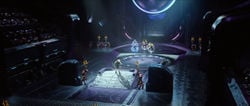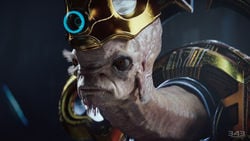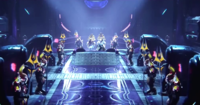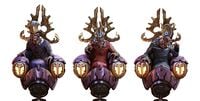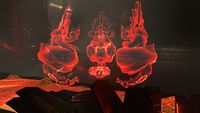Hierarchs
From Halopedia, the Halo wiki
| Hierarchs | |
|---|---|
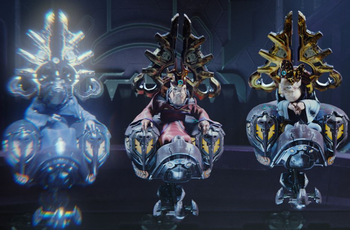
| |
| Political information | |
|
Type: |
Triumvirate |
|
Government: |
|
|
Member of: |
|
|
Duties: |
Leaders of the Covenant |
|
Term length: |
|
|
Headquarters: |
|
| Historical information | |
|
Formation: |
|
|
Abolished: |
|
|
Notable individuals: |
|
The Hierarchs, also known as High Prophets, ruled the entire Covenant, serving as the highest theocratic leaders in the High Council. Hierarchs rule with near absolute power over the Covenant, and the other races obey their will without question. The last three Hierarchs came to power in the beginning of the 9th Age of Reclamation in 2525.[1] The title of Hierarch was dissolved following the death of the High Prophet of Truth along with the dissolution of the Covenant on December 11, 2552.[2]
Powers and duties[edit]
The title of Hierarch had existed before the establishment of the Covenant, as early as 860 BCE.[3] By the time of the Covenant's formation, the Hierarchs were a triumvirate composed of three San'Shyuum that served as the highest authorities among the Covenant and held the most political and religious power.[1] The true duty of the Hierarchs was to help guide the Covenant toward the Great Journey.[4] The Hierarchs led the Covenant High Council. Hierarchs had complete control over the distribution of all Forerunner relics and technology—likely more so than the Ministry of Fortitude—and could distribute them however the Hierarch thought best benefited the Covenant.[5] If an individual failed a "holy mission" assigned to them by a Hierarch, dire consequences would result and execution may occur.[6] Among their powers are composition and reorganization of fleets within the Covenant naval branch, even without the approval of the High Council,[7] and appointing an Arbiter from among the Sangheili to serve as the "Will of the Prophets".[8] The Hierarchs also had the authority to create new Ministries within the Covenant, sometimes for the personal gain and ambition of one Hierarch.[9] The Hierarchs often issued edicts ex cathedra; these edicts may have comprised general declarations, though they typically contained executive orders. As they were extensions of the Hierarchs' will, these edicts could not be refuted.[10]
The Hierarchs typically remained in the Covenant holy city of High Charity, although they would occasionally embark to lead a battle. The Hierarchs often occupied the High Council Chamber to lead High Council sessions or hold court trials, along with the High Councilors of the Covenant. The Hierarchs could also assign duties and tasks to other members of the Covenant in the Hall of Sacred Guidance.[11] The Sanctum of the Hierarchs was the private quarters of the High Prophets that was only accessible to very high-ranking members of the Covenant.[12] The Palace of the Hierarchs was the private reception chamber used by the Hierarchs.[13]
The Hierarchs followed the Book of Hierarchs—an official ruling book.[14] Despite the Hierarchs' power and influence, they did not have right or power to stop the San'Shyuum that enforced the Roll of Celibates from completing their tasks.[15] A Hierarch assigning an important mission to individuals without informing the rest of the Hierarchs was considered a violation of Council protocol. However, the protocol was often violated. The High Prophet of Excellent Redolence tasked the Prophet of Inner Conviction with recovering a Luminary and female San'Shyuum on Janjur Qom without informing the rest of the Hierarchs.[11] The High Prophets of Truth and Regret often operated while keeping each other unaware of their separate, ambitious activities. Hierarchs could appoint other San'Shyuum to be their Secondary Administrator, essentially an assistant to the Hierarch.[13] Stewards would also serve as aids to Hierarchs.[16]
Each Hierarch was dressed in a loose-sleeved robe with different coloring. Hierarchs donned golden headdresses that displayed a blue holographic Halo installation on their forehead.[14] Hierarchs sat upon a gravity throne, luxurious anti-gravity chairs with gold, collar-like plating and were equipped with energy shielding.[17] The Hierarchs were always protected by the Covenant Honor Guard, with the Hierarch's personal guards always prepared to kill anything that attempted to harm the Hierarch. The Honor Guardsmen would also kill any individual that held an unholstered weapon in the presence of a Hierarch.[18] However, the Sangheili with the title of Arbiter seemingly were an exception to the law, as seen with Arbiter Ripa 'Moramee when he activated two Type-1 energy swords in front of a Hierarch.[19] The Hierarchs' gravity thrones were outfitted with a powerful gravity cannon that a Hierarch could use to annihilate any possible threat.[14][20]
Decrees and edicts[edit]
The following is a list of the known formal decrees and formal edicts made by the Hierarchs.
- "I must tell you that High Charity now has a new Ministry,"
- — Qurlom relaying a decree from the High Prophet of Excellent Redolence
 This section is a stub. You can help Halopedia by expanding it.
This section is a stub. You can help Halopedia by expanding it.
- "It is known the Kig-Yar ship Pitiless has brought forth an Unclean Being's corpse. Hear now, all Kig-Yar vessels are to be searched. Let faithful Sangheili lead teams of Unggoy to all Kig-Yar ships and seek further evidence of the Unclean. It is done."
- — High Prophet of Restraint
- "Hear now that 500 teams are to be formed to study the language of the Unclean. Each team to consist of the most clever and most educated Unggoy and Sangheili. These teams to speak only the Unclean language among themselves. The Unclean language to be taught to all military strike teams, that the foe shall be vulnerable."
- — High Prophet of Tolerance
- "All within the Covenant, hear now and obey. Weapons and ships of war to descend upon the inhabited world of Epsilon Indi. Strike with all force. No intelligent survivors may remain, upon severest penalty."
- — High Prophet of Truth
- "Hear now the infamy in Chi Ceti system. Due to lack of faith on the part of the crew of the vessel Unrelenting, a band of Unclean were able to board and slay. A Science Lance is ordered to be formed to study the captured weapons and armor that mitigation can be taken in future."
- — High Prophet of Regret
- "Let the Victory of Epsilon Indi be celebrated by fasting and prayer. Unggoy and Kig-Yar food rations to be eliminated for the next three work periods. Sangheili and Jiralhanae to spend two rest periods in public prayer. All attend the public monitors at the sounding of five bells to observe the execution of those who failed their duty at the Victory."
- — High Prophet of Regret
- "Return at fastest possible speed to the world they know as Harvest. We must learn the secrets inside the holy relic before the Great Journey can continue. The humans must not be allowed to enter the artifact; we will do whatever we must to deny them access. All must be resolute in this task, or face punishment."
- — High Prophet of Regret
- "It is known that there is a delay installing Luminaries upon newly constructed vessels of war. On each vessel still lacking a Luminary, 1 Unggoy worker out of every 64 is to be executed. To preserve discipline between the Sangheili overseers and Unggoy, choice of victim and execution is to be by Kig-Yar death squads. This is to continue daily until that vessel's Luminary is installed."
- — High Prophet of Truth
- "Hear now, all personnel to spend today's second rest period in attentive watchfulness before display monitors. All display monitors to show the humbling punishment of the Sangheili Supreme Commander of the Fleet of Particular Justice for failure, cowardice, and lack of faith."
- — High Prophets of Truth, Regret, and Mercy
- "In recognition of the virtue of the Jiralhanae, it is ordered that all Sangheili aboard the Fleet of Profound Solitude, The Fleet of Tranquil Composure, and the Fleet of Inner Knowledge to be completely replaced by Jiralhanae. Each removed Sangheili is to be assigned other duties. In celebration, all imprisoned or criminal Jiralhanae to be released, rehabilitated, and pardoned."
- — High Prophet of Truth
Appointment and succession[edit]
The inauguration of a new set of Hierarchs generally coincided with the beginning of a new Age. In order to become a Hierarch, a San'Shyuum would have to receive the "blessing" of the Oracle of High Charity. However, the Oracle had not spoken for millennia. Instead, the ascension process of a Hierarch was steeped in political machinations and often the bribery of the Oracle's keeper—the Philologist.[1][21] After speaking with the Oracle, the three San'Shyuum would announce their intentions to replace the current Hierarchs in front of the High Council and state their reasons. Although possible to announce their intent to the Council without a third San'Shyuum, it would make them seem less legitimate and a third individual would have to be selected after the announcement.[22] However, unseating a Hierarch was not an easy task, as the Hierarchs would often try to use all the influence they had at their disposal to keep their title and prevent the declaration of a new Age.[23] After being approved of by the High Council, a grand ceremony known as the Ascension would occur to formally declare the coming of a new Age and introduce the new Hierarchs to the rest of the Covenant. Then, the newly-risen Hierarchs would humbly ask the Oracle to bless the new Age. Upon their ascension, a Hierarch may choose a regal name from a list of former Hierarch names.[24]
During the appointment of a new Age and a new set of Hierarchs, it was acceptable for one of the previous Hierarchs to keep their title and position, and continuing serving as a Hierarch alongside two new ones. While this generally allowed for a smoother transition, bitterness would often ensure.[25] A Hierarch could step down from the throne if they believed that their health was becoming a concern.[9] However, a retired Hierarch could still voice their opinion in the High Council.[14] In the rare event of the death of a Hierarch, another high-ranking and influential San'Shyuum would be given the opportunity to replace the missing Hierarch.[13]
Known Hierarchs of the Reformists[edit]
- Main article: Reformists
- First Age of Conflict
Known Hierarchs of the Covenant[edit]
- High Prophet of Excellent Redolence (c. 850 BCE)
- High Prophet of the Glorious Journey (c. 850 BCE)
- High Prophet of Unity (c. 850 BCE)
- Unknown Age
- High Prophetess of Obligation (?–2525)
- High Prophet of Tolerance (?–2525)
- High Prophet of Restraint (?–2525)
- High Prophet of Regret (2525–November 2, 2552)
- High Prophet of Mercy (2525–November 3, 2552)
- High Prophet of Truth (2525–December 11, 2552; the last Hierarch of the Covenant)
Trivia[edit]

|
Browse more images in this article's gallery page. |
- Each of the three Hierarchs in the original Halo trilogy were killed by a different enemy of the Covenant faction. Regret was killed by UNSC, Mercy was killed by the Flood, and Truth was killed by Thel 'Vadam's Fleet of Retribution. It is also worthy of note that all three were eventually infected by the Flood prior to or immediately following their deaths.
- The High Prophetess of Obligation is currently the only known female Hierarch.
- Many Prophets have titles that are the polar opposite of how they actually act. The easiest example of this could be the Prophet of Truth, who lied and schemed his way to the position of Hierarch. The Prophet of Regret is also an example, as he regrets nothing until his blunder in the Battle for Earth.
- One notable exception is the Prophet of Tolerance, who promoted good relations between the Covenant's member species.
Gallery[edit]
A monument to the Prophet of Truth in Halo 2.
The Prophet of Regret speaking to Ripa 'Moramee in Halo Wars.
The death of the last Hierarch in Halo 3.
Art of the Hierarchs Regret, Mercy, and Truth for Halo 2: Anniversary.
The Hierarchs in Halo: The Television Series.
Artwork of the Hierarchs Regret, Truth, and Mercy for the Halo Encyclopedia (2022 edition).
A hologram of the Hierarchs in Halo Infinite.
List of appearances[edit]
Sources[edit]
- ^ a b c d Halo Encyclopedia (2011 edition), page 125
- ^ a b Halo 3, campaign level The Covenant
- ^ Halo: Broken Circle, Prologue
- ^ Halo Encyclopedia (2011 edition), page 126
- ^ Halo: Contact Harvest, page 159
- ^ Halo: The Cole Protocol, page 170
- ^ Halo: The Cole Protocol, page 349
- ^ Halo 2, campaign level The Arbiter
- ^ a b Halo: Broken Circle, chapter 2
- ^ Halo Wars: Timeline Events
- ^ a b Halo: Broken Circle, chapter 4
- ^ Halo: First Strike, pages 338-339
- ^ a b c Halo: Broken Circle, chapter 15
- ^ a b c d Halo: Broken Circle, chapter 13
- ^ Halo: Contact Harvest, page 265
- ^ Halo 2: Terminal 1
- ^ Halo Encyclopedia (2011 edition), page 136
- ^ Halo: The Cole Protocol, pages 144-145
- ^ Halo Wars, campaign level Scarab
- ^ Halo 2, campaign level Regret
- ^ Halo: Contact Harvest, page 274
- ^ Halo: Contact Harvest, pages 286-287
- ^ Halo: Contact Harvest, page 156
- ^ Halo: Contact Harvest, pages 379-383
- ^ Halo: Contact Harvest, page 268
